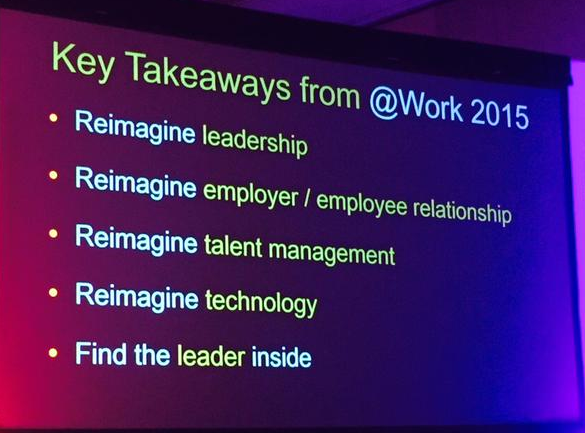Saba @Work 2015 conference
SureSkills, a European and North American Partner of Saba sent a team of management, HR and Learning & Development experts to the highly anticipated Saba @Work 2015 conference in Las Vegas earlier this month.
 There was a number of highlights and big announcements over the 4 days with the biggest takeaway being the Saba Cloud spring release! Saba Cloud is focused on enabling customers to build leaders at all levels of the organization, and empowering them with the intelligent tools to make it happen. As the economy improves and organizations grow, new leaders need to be brought on or up more rapidly than ever, to help drive the business from all levels. This is encouraging organizations in a race to: attract the right candidates with key leadership qualities, identify and advance hidden leaders internally who are ready for the next step, and measure talent processes vs industry peers to quickly address issues that could result in their attrition.
There was a number of highlights and big announcements over the 4 days with the biggest takeaway being the Saba Cloud spring release! Saba Cloud is focused on enabling customers to build leaders at all levels of the organization, and empowering them with the intelligent tools to make it happen. As the economy improves and organizations grow, new leaders need to be brought on or up more rapidly than ever, to help drive the business from all levels. This is encouraging organizations in a race to: attract the right candidates with key leadership qualities, identify and advance hidden leaders internally who are ready for the next step, and measure talent processes vs industry peers to quickly address issues that could result in their attrition.
The Saba Cloud Spring Release delivers powerful new capabilities and enhancements to address this challenge, helping our customers to attract, advance, and empower their leaders - and ultimately build a culture of leadership throughout the organization. While there are many features and enhancements available with this release, below are my top three focused squarely at this challenge.
Ruaidhri McSharry, SureSkills COO and event attendee commented "The emphasis of business value is increasing. Saba is a holistic Talent Management system that has learning – unified learning – at its heart. With intelligence based mentoring the “system” advised learners (staff) on courses to take that will enhance their position in the company."
According to Emily He, Chief Marketing Officer at Saba:
"The global business environment is rapidly changing. We have now seen 12 straight months of private-sector job gains above 200,000 – the first time that has happened since 1977. The private sector has added 12 million jobs over 60 straight months of job growth, extending the longest streak on record. Moreover, 2014 was the best year for job growth since the late 1990s and 2015 has continued at this pace. And people are reacting to this super-hot job market.
According to a survey Saba conducted with Harris Poll in December last year,
- In the US: 36% are planning to leave their jobs. And the majority polled plan to be out the door by July!
- 45% of millennials are looking to leave. And by 2020, the millennials and their younger cohorts will be 75% of the workforce.
- The average time in a job is shrinking too. Nearly 60% in workforce have been in their jobs less than 5 years, and ironically, they’re the most likely to leave…
And why are people leaving? According to the survey, opportunity for career growth is the number one reason for change (47%), and compensation is understandably next at 43%. But right behind them in the number three position is an interest in a job that delivers a better sense of purpose (38%). While 90% want control over their career paths more than half – 55% – expect their companies to actively contribute to their career development and plan for purpose.
So who is willing to lead this change in corporate business? Here’s the biggest disconnect of all:
- 68% of US workers consider themselves leaders – regardless of title, but by what they bring to the business
- But when it comes to title, only 12% aspire to the corner office What this data is telling us is: people are leaving because they want to find an environment where they can grow, where they can lead, and through doing that, they want to find a sense of meaning and purpose.
It’s time for us to reimagine leadership.
Leadership is no longer about command & control, about hierarchy, or status. Rather, leadership is about doing something that has purpose, exerting your influence, achieving mastery, and seeing the direct linkage between your contribution and the success of the business.
Leadership is no longer positional. It’s situational and deeply personal. It’s time to invert the age old saying - from "It’s not personal, it’s business…" to "If it’s business, it IS personal."
We need to create an environment where everyone feels that they can bring their whole selves to work. Where they are, or can be, a leader in their respective areas. An environment where there’re leaders at every level of the organization. We need to enable everyone to find the leader inside themselves.
But the question is, how do we do it? Start with a fresh perspective:
1. Reimagine the employer / employee relationship.
Traditionally, businesses had time to identify, train, and groom the next generation of leaders – or leaders were simply anointed based on time spend with the company or through effectively navigating office politics. Today, that expectation of a pool of leaders-in-waiting is vanishing as more employees move from job to job. So what do we do now? Ben Casnocha, the co-author of The Alliance, talks about how we can “acknowledge the probable impermanence of the relationship yet still seek to build trust and investment anyway.” And how we can make a new type of arrangement that opens the opportunity for a new brand of leadership. In this new brand of leadership, employees can lead and have the potential to make an immediate impact based on the fact that they are informed, enabled and empowered.
2. Reimagine talent management.
 In this age where culture, employee engagement and retention have risen to the top of the C-level agenda, it’s so important for HR and talent professionals to be the agents of change. And many companies, including Saba customers, are already doing that. We’re seeing some incredibly innovative and inspiring talent management practices being implemented across our customers. Zappos, who came to our user conference last year to present on the topic of happiness@Work, has implemented something called holocracy, a distributed authority system that bakes empowerment into the core of the organization. Donna Morris, SVP of Global People and Places from Adobe joined us on stage at Saba’s @Work 2015 Summit. She talked about how Adobe decided to abolish the performance stack-ranking, and instead implement a performance feedback process that allowed for much more frequent interactions between the employees and the managers. And Virgin, a company known for their fun personality and non-conformist attitude, embeds their brand value throughout talent management process – from recruiting, training to performance management – in order to ensure their hire people with the right attitude and empower them to do the right thing to provider superior service to customers.
In this age where culture, employee engagement and retention have risen to the top of the C-level agenda, it’s so important for HR and talent professionals to be the agents of change. And many companies, including Saba customers, are already doing that. We’re seeing some incredibly innovative and inspiring talent management practices being implemented across our customers. Zappos, who came to our user conference last year to present on the topic of happiness@Work, has implemented something called holocracy, a distributed authority system that bakes empowerment into the core of the organization. Donna Morris, SVP of Global People and Places from Adobe joined us on stage at Saba’s @Work 2015 Summit. She talked about how Adobe decided to abolish the performance stack-ranking, and instead implement a performance feedback process that allowed for much more frequent interactions between the employees and the managers. And Virgin, a company known for their fun personality and non-conformist attitude, embeds their brand value throughout talent management process – from recruiting, training to performance management – in order to ensure their hire people with the right attitude and empower them to do the right thing to provider superior service to customers.
3. Reimagine how to better leverage technologies to promote employee engagement and improve employee retention.
How can we use predictive analytics and prescriptive recommendations tools to better guide employees to pursue their career aspirations and take control of their own destiny? And how can C-level executives and managers take advantage of industry benchmarking data to identify their superstars and enable leaders at all levels? How can we leverage the internet of things to further embed talent management processes in people’s day-to-day lives and to both promote wellness and enable them to learn and grow the way they want to? How can we manage robots as part of the future workforce? After all, Amazon had 15,000 robots, along with 15,000 employees, packing and moving packages during last holiday season. Most importantly, how can today’s business, HR and Learning leaders help transform your business? Developing an organization that values and promotes leaders at all levels won’t happen overnight. The change can start with you, with your ability to serve as a positive example. How can you find the leader inside? What can you do to help your organization create leaders at all levels?"
Source: Saba.com/us/blogs